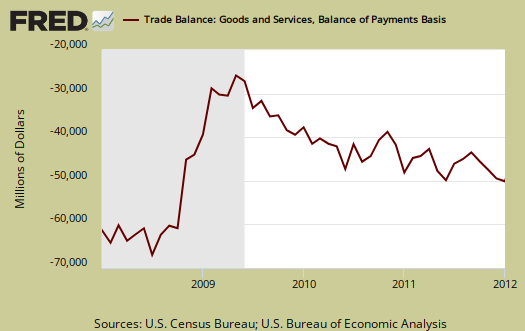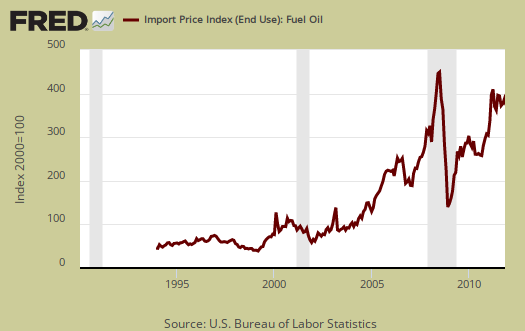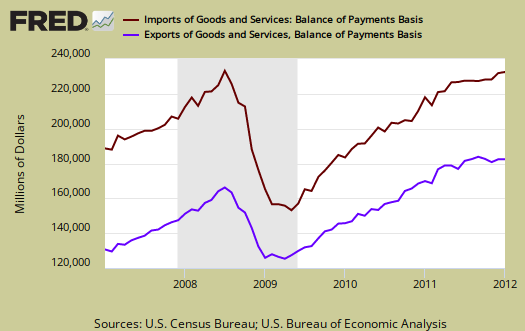The January 2012 U.S. trade deficit increased $2.14 billion to $52.57 billion in a month. This is a 4.25% increase from last month in the trade deficit and the highest since October 2008. December's trade deficit was significantly revised up by $1.62 billion. All of 2011 was revised, painting a much bleaker trade deficit picture than originally reported. January exports increased $2.58 billion, or 1.45%, while imports increased $4.72 billion, or 2.07%. January's imports, $233.37 billion, were the highest on record.

The China deficit alone was, -$26.023 billion, or 39.86% of the goods trade deficit for January. This includes oil, is not seasonally adjusted and is on a raw customs accounting basis. For comparison's sake the not seasonally adjusted goods trade deficit by Census accounting methods was -$65,29 billion. By country trade deficits are not seasonally adjusted and China's never ending import barrage is cyclical as one can see in the below graph of the deficit with China.

Oil related imports jumped $2.5 billion with a petroleum end use trade deficit of -$29.71 billion, for January, a 9.2% increase from last month. Petroleum related end use is 44.68% of the goods trade deficit.
By the more specific NAICS codes, not seasonally adjusted, oil and gas were 41.2% of the goods trade deficit, or -$21.58 billion. Assuming China has very little oil and gas exports to the United States, if one subtracts off oil and gas from the goods trade deficit, China becomes very roughly 66% of the non-oil and gas goods trade deficit.
The United States basically has two major ongoing problems with the trade deficit, Chinese goods and Oil imports. Below is the not seasonally adjusted import price index for oil fuel. The average price for a barrel of oil in January was $103.81, down from December's price of $104.13. By volume, the U.S. imported 270,727,000 barrels of crude oil in January, about 8.2 million less than December. With this kind of trade data, one must wonder why gas prices are skyrocketing.

Below are imports vs. exports of goods and services from January 2007 to December 2011. Notice how much larger imports are than exports, but also notice the growth, or rate of change between months of U.S. exports over time. To state the obvious, imports subtract from GDP and exports add.

Below is the list of good export changes from December to January, seasonally adjusted. Of industrial supplies, believe this or not, the largest decrease was -$1.241 billion in fuel oil exports. The saving grace was auto exports, along with capital goods. Capital goods had healthy increases in computer accessories, aircraft, semiconductors.
- Automotive vehicles, parts, and engines: +$1.050 billion
- Industrial supplies and materials: -$0.295 billion
- Other goods: -$0.548 billion
- Foods, feeds, and beverages: +$0.097 billion
- Capital goods: +$1.296 billion
- Consumer goods: -$0.215 billion
Exhibit 7 gives Census accounting method breakdown for exports.
Here are the goods import monthly changes, seasonally adjusted. While we see better news above in auto exports, imports ballooned $2.4 billion.
Believe this or not, we imported $3.238 billion in toys, sporting goods for January.
- Industrial supplies and materials: +$1.108 billion
- Capital goods: +$0.048 billion
- Foods, feeds, and beverages: +$0.437 billion
- Automotive vehicles, parts, and engines: +$2.387 billion
- Consumer goods: +$0.171 billion
- Other goods: -$0.139 billion
Running a trade deficit in advanced technology is not a good sign for those jobs of tomorrow. This month the advanced technology deficit dropped to a mere $6.7 billion (sic).
Advanced technology products exports were $22.5 billion in January and imports were $29.2 billion, resulting in a deficit of $6.7 billion. January exports were $3.7 billion less than the $26.2 billion in December, while January imports were $5.0 billion less than the $34.2 billion in December.
Here is the breakdown with major trading partners, not seasonally adjusted. China is the worst trade deficit, as detailed above.
OPEC can be assumed to be oil and the OPEC nations are: Algeria, Angola, Ecuador, Iran, Iraq, Kuwait, Libya, Nigeria, Qatar, Saudi Arabia, United Arab Emirates, Venezuela.
The January figures show surpluses, in billions of dollars, with Hong Kong $2.1 ($2.5 for December), Australia $1.6 ($1.7), Singapore $0.8 ($1.3), and Egypt $0.2 ($0.2).
Deficits were recorded, in billions of dollars, with China $26.0 ($23.1), OPEC $10.0 ($9.1), European Union $8.5 ($9.6), Japan $6.2 ($6.5), Canada $4.8 ($3.9), Mexico $4.2 ($4.9), Germany $4.1 ($4.8), Ireland $2.3 ($2.8), Venezuela $2.0 ($2.0), Korea $1.4 ($0.5), Taiwan $1.3 ($0.8), and Nigeria $1.3 ($1.3).
In 2008, we broke monthly total trade deficit figures of $60 billion. This includes goods and services. From a year ago, the trade deficit is clearly increasing:
The goods and services deficit increased $5.0 billion from January 2011 to January 2012. Exports were up $12.9 billion, or 7.7 percent, and imports were up $18.0 billion, or 8.4 percent.
Here is the BEA website for additional U.S. trade data.
You might ask what are these Census Basis versus Balance of Payment mentioned all over the place? The above mentions various accounting methods so we're comparing Apples to Apples and not mixing the fruit. The trade report in particular is difficult due to the mixing of these two accounting methods and additionally some data is seasonally adjusted and others are not. One cannot compare values from different accounting methods and have that comparison be valid.
In a nutshell, the Balance of Payments accounting method is where they make a bunch of adjustments to not count imports and exports twice, the military moving stuff around or miss some additions such as freight charges. The Census basis is more plain raw data the U.S. customs people hand over which is just the stuff crosses the border. The 2005 chain weighted stuff means it was overall modified for a price increase/decrease adjustment in order to remove inflation and deflation time variance stuff.
Bottom line, you want just the raw data of what's coming into the country and going out, it's the Census basis and additionally the details are only reported in that accounting format. Additionally the per country data is not seasonally adjusted so watch out trying to add those numbers into the overall trade deficit. It's a statistical no-no to mix seasonal and non-seasonally adjusted numbers.
The Census is also getting into the graphing game with some nice pie charts breaking down exports by country, as well as a chart showing petroleum as an overall percentage of the trade deficit.

the press on China's "deficit" is fiction
Playing catch up on writing but bottom line, all of the headline buzz today on China running a deficit is pure spin. China has a month long holiday and always runs a deficit in February as a result. The country's manufacturing machine basically shuts down. Don't think for a second China is letting up on export flooding.